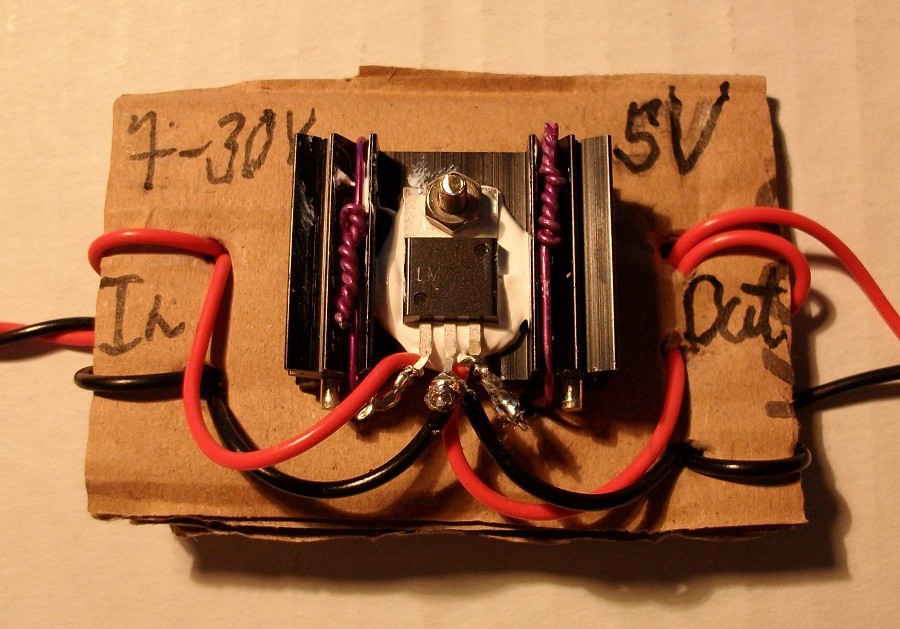-
5 V Voltage Regulator
10/19/2020 at 06:19 • 0 commentsThis article shows explains a simple implementation of 5 V voltage regulator IC, LM7805.
You can see the performance of my circuit in this video:
Step 1: Make the Circuit
I did not include any input or output capacitors specified in the LM7805 datasheets.
![]()
Step 2: Testing
The analogue multimeter is tuned to zero when disconnected. The 5 V voltage regulator is providing a voltage slightly above 5 V:
![]()
Read this link for more information about heat sink selection:
-
Capacitor Safety
08/30/2020 at 08:53 • 1 commentThis article shows the basics of capacitor safety.
1. My Story
When I was a teenager we used to Soviet mains powered have film projector. This project had a small AC motor, that was used to roll the film. It had a capacitor or varistor connected in parallel across its terminals. This component was used to filter electrical spikes that the AC motor was generating.
One day the projector begin to emit electromagnetic interference. This is because the electrical spike filtering component failed. Me and my parents went to the local electronics store and purchased an electrolytic capacitor.
My dad soldered the capacitor to the small AC motor, turned ON the projector witnessed a loud explosion of the electrolytic capacitor.
This is what we have done wrong:
1. The capacitor value must have been about 100 uF. When connected to AC signal the impedance was: Xc = 1 / (2*pi*fc*Ci) = 1 / (2*pi*50 Hz*(100*10^-6 F)) = 31.8309886184 ohms or 26.5258238486 for 60 Hz mains signals. This is a very small value that will pull high current from the power supply. We should have used a smaller capacitor because most filtered electric spikes are high in frequency.
2. Maximum voltage rating. This was actually correct. We have chosen a capacitor with a voltage rating well above 220 V.
3. Maximum current rating. We did not ask the shop assistant about current rating. It is most likely that the current rating was easily exceed in the first few milliseconds of the projector turning ON. The capacitor is initially a short circuit for DC inputs and causes time delay for AC inputs. For DC inputs maximum required capacitor current rating can be calculated by dividing the power supply voltage over internal resistance. However, some professionals might disagree with this statement.
4. Maximum power rating. Maximum power rating is the maximum voltage multiple by the maximum current. This rating also should not be exceeded.
5. Average rating. Exceeding specified average power, voltage and current ratings might not cause immediate failure of component reduce the component life span.
6. Most motors have a varistor connected across their terminals to filter the high frequency spikes. Not capacitors. At that time we could not tell the different.
This is why nowadays when you buy a part in a local electronics store they always ask you what it is for.
2. Dangers of Capacitor Blowing Up
Most cylindrical capacitors could be very dangerous when they blow up. The cap will fly a few metres into the air at high speed and strong force. There will also be a loud bang sound. The flying parts of those capacitors can cause an injure to human body. This includes:
- scars,
- ear damage,
- eye damage.
- small pieces entering the body.
3. Charging the Capacitor
Many people think they can connect an electrolytic capacitor directly to power source. Usually this is true for low current or low voltage batteries. You might be able to get away buy connecting a 470 uF capacitor directly to 6 V battery powered supply. However, many people blow up electrolytic capacitors as small as 100 uF by connecting them to 12 V car battery.
4. Discharging the Capacitor
I have seen some technicians/repairs people discharging the capacitors buy simply shorting the two terminals with pliers. This is a very bad practice that will not only damage the capacitor but might even cause the capacitor to explode.
This is video from DigiKey shows how you can safely discharge a capacitor:
5. References
1. Varistors: https://www.electronics-tutorials.ws/resistor/varistor.html
My Pages
Projects I Like & Follow
Share this profile
ShareBits
Become a Hackaday.io Member
Create an account to leave a comment. Already have an account? Log In.


 PK
PK Mark Peng
Mark Peng Danny Bokma
Danny Bokma Scott Clandinin
Scott Clandinin Maakbaas
Maakbaas sjm4306
sjm4306 SHIVANI
SHIVANI AskSensors
AskSensors alnwlsn
alnwlsn Marius Taciuc
Marius Taciuc Ayush Kumar Lall
Ayush Kumar Lall vybhav-nag
vybhav-nag J. Blake Harris
J. Blake Harris